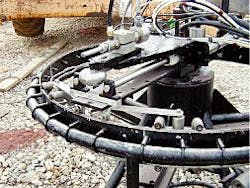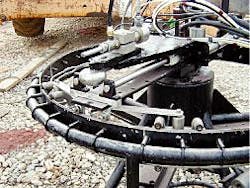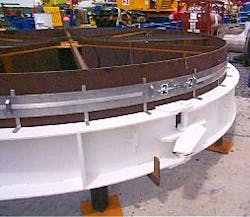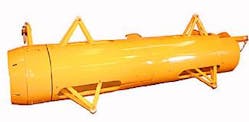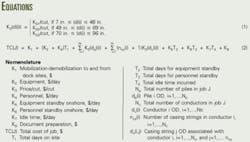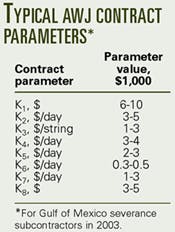Abrasive cutting is one option available to the industry for severing platforms during decommission operations. This type of cutting involves injecting abrasive materials into a water jet to wear away steel or concrete.
This second in a five-part series on Gulf of Mexico platform decommissioning discusses abrasive cutting methods and the service contracts involved in the operation.
Part 1 of the series (OGJ, Sept. 27, 2004, p. 41) discussed factors involved in severance selection.
Abrasive-water jets
Industrial and manufacturing processes have used abrasive cutting technologies for many years. These technologies are classified either as low pressure, high-volume sand cutters or high pressure, low-volume jet cutters.
Sand cutters use sand or slag mixed with water to produce a low 4,000-10,000 psi pressure stream with a high 80-100 gpm volume. Abrasive jet cutters, on the other hand, use garnet or copper slag injected at the nozzle to produce a high 50,000-70,000 psi pressure stream with a low 50-80 gpm volume.1 These abrasives provide the cutting force and are introduced at the cutting nozzle through a hose with air pressure or with a water-based fluid. The cutting nozzle has a diamond orifice to lessen erosion.
Sand cutters use a turning mechanism or power swivel similar to a mechanical cutter. The operation involves connecting the power swivel to the top of an open tubular member and then turning a drill string. In the process, the cutting nozzle severs the caisson and casing strings through the abrasive action of the water jet.
Abrasive jet cutters can cut a tubular member internally or externally. The preferred method for piles is an internal cut if the piles allow for below-mudline access.
A standard abrasive water-jet (AWJ) unit consists of a cutting tool (Figs. 1-3) for controlling the nozzle position and movement, an abrasive mixing or dispensing unit, high-pressure water pumps and hydraulic power unit, control panels, and cut monitoring systems.2 Figs. 4 and 5 show a typical AWJ cutting spread.
In a conventional internal pile-cutting operation, a wireline winch (deployment frame) or a construction vessel crane lowers the cutting tool into the pile. Arms on the tool's centralizing system stabilize the tool and position the cutting nozzle against the pile wall.
The operation includes a diesel-driven water pump to supply a high-pressure water stream to the cutting nozzle. Cut parameters such as wall thickness and cut configuration determine the required pressure.
An operator at the surface control station controls and monitors the cutting speed, travel direction, and nozzle position of the cutting tool. External cutting operations on legs, piles, and braces require a diver or remotely operated vehicle installed in tracks (Fig. 6).
Both internal and external cutting operations typically include subsea video equipment, lights, and audio systems for observing and monitoring the cut.
Environmental impact
All cutting operations require the expenditure of energy that may have a negative impact on the ocean environment. For instance, a cutting spread requires about 200 hp or 150 kw, which is about the same power required by a small offshore fishing vessel. Unlike a typical sport fishing vessel, however, the typical cutting spread is fully self-contained with no marine discharges other than the jet in the case of AWJ systems.
Nonexplosive cutting methods are an ecological and environmentally sensitive severance method because they do not create the impulse and shockwave induced by explosives. For that reason, the academic and trade literature contains limited environmental and physical impact data on nonexplosive techniques.3 We could find no record of negative environmental impacts for nonexplosive cutting methods in the literature.
Mechanical, AWJ, and diamond-wire cutting methods require diesel-fueled motors that cause vibrations, emit CO2 and other gases into the atmosphere, and potentially produce low-frequency sound waves into the marine environment.
AWJ cutting involves the use of seawater and garnet or copper slag (grit), which may impact the marine environment. But the impact is believed to be inconsequential because the fluid is seawater and the grit is essentially inert. Also, the level of copper in the slag is very low and currently the slag has no reported environmental issues or regulatory restrictions on its use. Garnet is an inert rock material with no reported environmental consequences.
The noise level of the supersonic cutting jet is safe for divers and is not considered harmful to marine life.
Mechanical, AWJ, and diamond-wire methods generally are considered harmless to marine life and the environment. The direct products of the processes are water, metal cuttings, and abrasive particles.
Cutting regulations
Lessees and platform operators must submit for approval an application to the US Minerals Management Service (MMS) and provide information on the structure and removal technique employed in platform decommission work. All structure removals require an environmental assessment, and if explosives are used, an Endangered Species Section 7 Consultation.
Offshore construction contractors cannot control the marine environment as easily as land-based demolition crews; therefore, the MMS instigated several regulations in 1986 to protect marine mammals and sea turtles during severing operations with explosives.
Part 4 of this series will discuss these regulations in greater detail. In brief, if the decommissioning includes explosives for cutting, the work requires qualified observers to monitor the area around a site for 48 hr prior to, during, and after detonation of charges. Also required is a 30-min aerial survey 1 hr before and after each blasting episode. In addition, the regulations allow detonation of explosives only between 1 hr after sunrise and 1 hr prior to sunset.4
These restrictions on explosives have encouraged operators to find alternative methods, such as abrasive cutting, for severing platforms.
Abrasive cutting eliminates:
- Special permits.
- The National Marine Fisheries Service observers and the 48-hr ocean search.
- Pre and post-blast helicopter and diver survey.
- Daylight time restrictions.
- Potential delays if marine life is in the area.
- Pile flaring that may occur with explosives and require additional diving operations.
Service contract characteristics
Cost recovery is the primary characteristic of a service contract. A general service contract must account for the service cost plus the cost to remain in business.
All service contractors have ownership (fixed) and operating (variable) costs. Contractors typically charge the customer a portion of their ownership costs and all operating costs associated with the work.
Fixed costs are those that do not vary with the service provided. They include, but are not limited to, administration, office services, insurance, legal support, contributions to health and pension plans and social security, workers compensation, salaries and wages, interest charges on the money tied up in the equipment, and expenses associated with maintaining and storing the equipment.
Variable costs include the personnel required to operate equipment, consumables, maintenance, wear, and equipment failure during an operation.
All costs are partially fixed and partially variable. Allocation of these elements into one class or another is sometimes a matter of individual preference as well as convenience.
The operator has many ways in which to allocate fixed and variable cost, and because fixed costs, and to a lesser extent variable costs, vary among contractors, service contract terms and conditions vary in a market environment.
In a competitive market environment, the charge for service typically equals the cost of performing the service plus a risk-adjusted market premium. A competitive market may have a 10% market premium, while in a less competitive environment, the market premium may exceed 25%.
Standard contract
The severance subcontractor agrees to provide cutting services as defined in the terms and conditions of work. Cutting services are usually written on a time and material basis with respect to the following elements:
- Mobilization-demobilization to and from dock sites, $K1.
- Equipment, $K2/day.
- Price/cut, $K3/cut.
- Personnel, $K4/day.
- Equipment standby onshore, $K5/day.
- Personnel standby onshore, $K6/day.
- Idle time, $K7/day.
- Document preparation, $K8.
Each contract's terms and conditions are unique; therefore, the following discussion only highlights the primary terms involved.
The mobilization-demobilization cost to and from the dock sites is specified at a fixed cost $K1 and covers the cost of the service provider to transport all personnel, equipment, and materials from company facilities to dockside.
The value of K1 depends on the distance between the service facility and the dockside locations, the size and weight of the equipment modules that need to be transported, and the form of the transportation arrangement negotiated.
An AWJ system may weigh 5-15 tons and have a footprint of 200-400 sq ft. Ground transportation requires lifting equipment and an 18-wheel truck.
The major cost elements in the operation of AWJ systems include the capital cost of the equipment and cost of maintenance, power, abrasives, nozzles, and hoses.
Commercially available AWJ systems cost from $250,000 to $500,000.
The age of the system typically determines the maintenance cost of the equipment, and in general, hydraulic systems, pumps and motors are high-maintenance items.
The barge contractor typically provides the water, electricity, air, and diesel fuel for the AWJ equipment at no cost while the AWJ service subcontractor must recover the cost of consumables through the rate structure. Consumables include nozzles and hoses that wear out and the cutting abrasives.
The AWJ service provider charges the jet cutting unit and related equipment at a usage rate $K2/day. This rate should cover a portion of the capital cost and maintenance and wear of the machine during the expected life of the equipment, as well as all variable costs associated with the operation.
Day rates depend on the manner in which the subcontractor needs to recover its fixed cost, which to some extent, also fluctuates with the supply and demand for cutting services in the gulf.
The usage rate includes a separate charge that is expensed for the number of cuts needed based on the size and type of each cut.
The casing strings in a well may or may not be grouted, and depending upon the cutting equipment employed and casing eccentricity, the work may involve cutting all strings in one pass before removing the casing or cutting and removing each casing string separately.
Service contractors specify the configuration charge variously, but typically they base the rates on the diameter, d(i), of the element to be cut or through diameter classes, as shown by Equation 1 in the equation box.
Engineering calculations determine the specific value of the charge based on the equipment's operational wear and the expected cutting time. The term K3(d(i)) is typically linear in d(i) indicating that the time to cut steel is proportional to the diameter of the element. If the rate structure determination includes factors such as the steel thickness or water depth of the cut, then K3(d(i)) may depart from linearity.
Service contractors charge personnel on a per diem basis ($K4/day) to provide 24-hr service availability. AWJ subcontractors in the gulf usually maintain a three or four-person crew/12-hr shift.
Other charges such as equipment standby ($K5/day), personnel standby ($K6/day), and idle time ($K7/day) depend on the personnel and equipment involved and are charged on an as-need basis. For large abandonment projects, such as multiple jackets or full-field removals, equipment standby essentially serves as insurance, providing a backup in case of component breakdown.
Because the work may involve doing several jobs during a single mobilization, each job may not have a separate mobilization-demobilization cost. For example, the crew and equipment may move from site-to-site. In this case, an idle time charge replaces the mobilization-demobilization cost when the crew and equipment move to a different site instead of returning ashore.
North Sea service contracts typically have a document preparation and a closeout report charged at a flat fee, $K8. This cost component is not usual in the gulf.
In a typical operation, the barge contractor picks up the cutting crew and equipment at dockside, provides their meals and board while on the barge, and then returns them back to dockside or another site when the service is complete.
All charges commence and terminate at the departure point.
Each contract has unique terms and conditions, but the contractor usually is responsible for ensuring that mud, clay, and other obstructions are not inside the piles. The cutting subcontractor may provide specialized jetting equipment for this service, but more often, the derrick-barge crew performs this service.
The barge contractor provides accommodation and living expenses for the cutting crew either without cost or at cost plus 15%.
The subcontractor charges as extra work changes in the scope of work and technical complications, such as hangers or bent stabbing guides that prevent placement of cutting tools.
Total cost
A cutting contractor's job specifications depend on the platform's location and the number, size, and type of piles and conductors that need to be cut. Water depth may affect the costs because greater water depths increase the time to go in and out of the hole. Also, greater hydrostatic pressure may have a negative impact on the performance of the cutting jet.
In deep water, abrasive cutting cost increases because the performance and reliability of cutting decreases.
Piling consists of hollow steel tubing welded together in sections and driven through the legs of the platform jacket. The piles secure the structure to the seafloor and are characterized by their diameter, wall thickness, and slope. To provide additional structural support, the piles may have grout either on the inside or outside.
Conductor characteristics include the diameter and wall thickness, as well as the number and type of casing strings within the conductor, the eccentricity of the strings within the annuli, and the material that resides between the annuli of the strings. This material may include mud, drilling fluid, water, or grout.
A job can be described with the following notation:
- Np(J) = Total number of piles in job J.
- dp(i) = Pile i OD, i=1,...,Np.
- Nc(J) = Total number of conductors in job J.
- dc(i) = Conductor i OD, i=1,...,Nc.
- ncs(i) = Number of casing strings in conductor i, i=1,...,Nc.
- dc(i,j) = Casing string j OD associated with conductor i, i=1,...,Nc, and j=1,.... ncs.
- The following variables specify the work activity required to complete job J:
- T1(J) = Total days on site.
- T2(J) = Total days for equipment standby.
- T3(J) = Total days for personnel standby.
- T4(J) = Total idle time incurred.
Equation 2 calculates the total cost of the job.
Parameter specifications
The scope of the work determines the values for Np(J), Nc(J), ncs(i), dp(i), dc(i), and dc(i,j), and in theory these values are known prior to the start of the job. Values for Np(J), Nc(J), and dp(i) are available from public records, while data to determine ncs(i), dc(i), and dc(i,j) requires more specific information on tubular wall thickness, grout, casing string eccentricity, etc. Blueprints, operator records, and on site inspection can provide this data.
Values for T1(J), T2(J), T3(J), and T4(J) are obtained from job records.
Some contractors may bring a cutting crew to the site on a just-in-time basis, while other contractors may allow the service provider a greater time window to perform their activities.
The subcontractor will usually record some of these values in the work log, but as a practical matter, the values generally are not available. Hence, we assume T2 (J) = T3(J) = T4(J) = 0 and write T1(J) = T(J).
The table shows a range of typical values for Ki for i=1,U,8.
References
1. An assessment of techniques for removing offshore structures, National Research Council, National Academy Press, Washington, DC, 1996.
2. Brandon, J.W., et al., "Abrasive water-jet and diamond-wire cutting technologies used in the removal of marine structures," Paper No. OTC 12002, Offshore Technology Conference, Houston, May 1-4, 2000.
3. Kaiser, M.J., Pulsipher, A.G., and Byrd, R.C., "Operational and Socioeconomic Report on Nonexplosive Removal of Offshore Structures," prepared by the Center for Energy Studies, Louisiana State University and Twachtman Synder & Byrd, Inc., US Department of Interior, Minerals Management Service, Gulf of Mexico OCS Region, New Orleans, September 2003.
4. "Taking and importing marine mammals; taking bottlenose dolphins and spotted dolphins incidental to oil and gas structure removal activities in the Gulf of Mexico," Federal Registry, Vol. 67, No. 148, Aug. 1, 2002, pp. 49869-75.
The authors
Robert C. Byrd is a principal at Twachtman Snyder & Byrd Inc., Houston, and is responsible for engineering and consulting services. He is a former Coast Guard officer and has more than 25 years' experience in the offshore oil and gas industry. For the past 10 years, he has focused on offshore platform decommissioning. Byrd has a BS in marine engineering from the US Coast Guard Academy and a PhD in engineering from the University of California, Berkeley.
Photos and biographical sketches of Mark J. Kaiser and Allan G. Pulsipher appeared in the first part of this series (OGJ, Sept. 27, 2004, p. 41).
